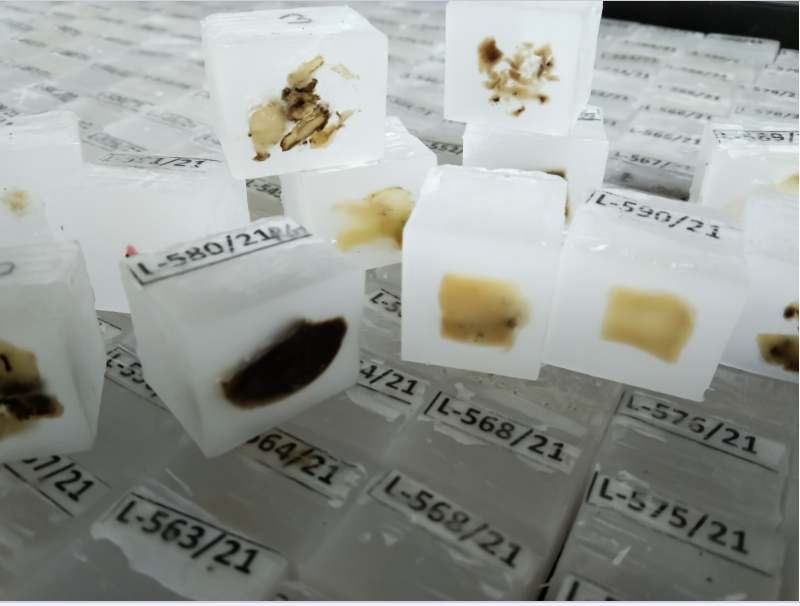Handling Human Tissue FFPE Blocks: Best Practices for Researchers and Lab Personnel
Written by: BioSample Connect Staff

Formalin-Fixed Paraffin-Embedded (FFPE) tissue blocks are invaluable resources in biomedical research, particularly in the fields of oncology, pathology, and molecular biology. Ensuring the proper handling and processing of these specimens is crucial for obtaining reliable and reproducible results. At BioSample Connect, we prioritize the highest standards of care and precision in handling FFPE blocks. Here are the best practices for researchers and lab personnel to follow.
1. Proper Storage Conditions
FFPE blocks must be stored under appropriate conditions to maintain their integrity over time. The ideal storage environment is a cool, dry place with consistent temperatures between 15°C and 25°C (59°F to 77°F). Avoid fluctuations in temperature and humidity, as they can lead to degradation of the tissue and paraffin matrix.
Tip: Use temperature-controlled storage cabinets or dedicated storage rooms to ensure optimal conditions.
2. Accurate Labeling and Documentation
Accurate labeling of FFPE blocks is essential for traceability and future reference. Each block should have a unique identifier that corresponds to detailed documentation, including the source of the tissue, date of collection, type of fixative used, and any relevant clinical information.
Tip: Implement a robust labeling system with barcodes and digital records to reduce the risk of errors and misidentification.
3. Minimizing Contamination Risks
Contamination can compromise the integrity of FFPE samples, leading to unreliable results. To minimize contamination risks:
- Always use clean, sterilized equipment.
- Work in a clean, designated area free from potential contaminants.
- Wear appropriate personal protective equipment (PPE) such as gloves, lab coats, and face masks.
Tip: Implement strict protocols for handling and processing FFPE blocks to maintain a sterile environment.
4. Sectioning Techniques
Proper sectioning of FFPE blocks is crucial for obtaining high-quality tissue slices for analysis. Use a microtome to cut thin sections (typically 4-5 micrometers thick) and ensure the blade is sharp and clean. Place the sections on positively charged glass slides to enhance adhesion.
Tip: Regularly maintain and calibrate the microtome to ensure precise and consistent sectioning.
5. Deparaffinization and Rehydration
Before staining or other downstream applications, FFPE sections need to be deparaffinized and rehydrated. This involves:
- Immersing the slides in xylene to dissolve the paraffin.
- Rehydrating the tissue through a series of graded ethanol solutions, ending with water.
Tip: Ensure adequate ventilation when working with xylene and other solvents, and follow safety guidelines for handling hazardous chemicals.
6. Antigen Retrieval
Formalin fixation can mask antigens, making them inaccessible to antibodies in immunohistochemistry (IHC) applications. Antigen retrieval techniques, such as heat-induced epitope retrieval (HIER) or enzymatic retrieval, can restore antigenicity.
Tip: Optimize antigen retrieval conditions (e.g., buffer type, pH, and retrieval time) for each specific antibody to achieve the best results.
7. Quality Control
Implementing quality control measures is essential for ensuring the reliability of your research. This includes:
- Regularly checking the integrity of stored FFPE blocks.
- Validating staining protocols and reagents.
- Running control samples alongside experimental samples.
Tip: Document all quality control procedures and results to maintain a record of the sample's handling and processing history.
8. Ethical Considerations
Always adhere to ethical guidelines and regulations when handling human tissue samples. Ensure that all specimens are obtained with proper consent and that patient confidentiality is maintained.
Tip: Stay informed about the latest ethical guidelines and institutional policies regarding human biospecimen research.
Conclusion
Handling FFPE tissue blocks with care and precision is crucial for the success of biomedical research. By following these best practices, researchers and lab personnel can ensure the integrity of their samples, leading to more reliable and reproducible results. At BioSample Connect, we are committed to providing high-quality biospecimens and supporting researchers in their quest for scientific discovery.
For more information on our offerings and how we can support your research, visit BioSample Connect.
Sources:
- National Center for Biotechnology Information (NCBI) - Best Practices for Handling FFPE Samples: NCBI Link
- Nature Protocols - Handling and Processing of FFPE Samples: Nature Protocols Link
